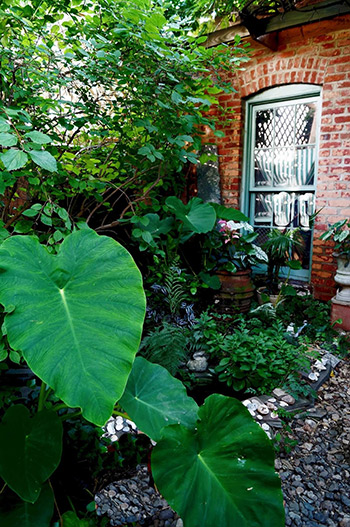
Yes, elephant ears! Ears of African elephants, mind you, not Indian ones. / Photo above and on front by Stephanie Cavanaugh.
IN MY GARDEN of many experiments and few successes, the elephant ears are always an unqualified delight. Much like the wandering jew that meanders here and there, easily filling bald patches at the poke of a chopstick, the colocasia (just looked that up so’s I’d look knowledgeable) devour space with glee, and need no care whatsoever—with the exception of setting the bulb with the bit that’s supposed to bud at the top (and I’m not even sure about that, or sometimes which is the top).
I buy a bag of a dozen for 10 bucks or so each spring at Costco or Home Depot and stick them behind pots, in front of the garage window, beside the pond, behind the cherry tree, hiding the straggly base of the honeysuckle, and higgledy-piggledy every elsewhere.
Water, don’t water, fertilize, don’t fertilize, sun no sun, up they come, sooner or later—the timing pretty much depending on how deep I’ve planted them. Though tropical, and technically not likely to survive our winters, there’s always an outlier or two that manages to weather the frost. Several poked up and said a surprise hello this summer.
Planting too deep is a common mistake. I’m forever treating them like tulips, with six inches or so above their heads, and then they sit there until—um, last week in one case—the plants emerge. And, since the wait is lengthy, and I have a hinky memory (as I believe I mentioned as an after-effect in my near-death sonata. If I neglected to, a hinky memory is an after-effect), the spots must be marked. Chopsticks are also excellent for this: The Prince bought me a pack of 100 a couple of years ago so I wouldn’t go planting something else on top of the bulbs or step on an emerging sprout.
And I watch and wait as weeks go by and sometime in early July, when maybe only four have unfurled their leaves, I heave a great despairing sigh and end up buying a few well-sprouted specimens—often for more than 10 bucks each—at some garden center or other. Of course, the following week the bulbs I’d already planted start poking up and sneering at me. Patience is not my middle name.
Happily, you can still find some around this late in the season; I saw several just yesterday on sale at Frager’s garden shop on Capitol Hill.
The ones that come up fastest are crowded in clay pots, covered with just a couple of inches of dirt (topped with some poked-in wandering jew so I remember I’ve planted them), and set on the back porch steps. Far faster than those in the garden, they’ll be leafed out and ready to be replanted in the yard where some disaster needs covering. The fact that shallow planting in a pot brings swifter growth is something that year after year I fail to recall. You can just leave them in their pots once they’ve sprouted, but for the leaves to reach a truly voluptuous scale they do best moved directly to the garden soil.
Technically, I suppose, elephant ears are much too large for this little space; their mammoth leaves add even more shade to the shade, so I’m constantly moving this and that to chase the spotty sun. But then, I don’t do much of anything in a small way, happily following the counterintuitive dictum that large-scale anything makes a small space feel bigger—and the hibiscus and African gardenia, which are currently not at all happy, will recover nicely in the greenhouse this winter.
In the meantime, what giddy joy these jungle leaves bring to August, when little is in bloom and much of what’s left is bedraggled. Blast the Bob Marley and bring on me rum.
—Stephanie Cavanaugh
Gardener Cavanaugh is working on a book about urban gardening. To read her earlier columns, type “Green Acre” in the Search box at the top of the screen.
